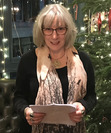Watching the Detectives?
A question asked in my online writing group got me thinking. I find it very strange that new writers are in such a rush, after finishing their first draft, to submit straightaway. Oh, yes I can understand their excitement at finishing a first novel, or story. Of course, you want to show the world what you’ve created because you’re excited by it but hold back, it isn’t finished yet.
I love editing. It’s when all my best ideas gather as I work my way through the first draft. Editing is like playing the part of a detective, you can only solve the crime once you have all the facts. It doesn’t matter what genre your book/story is about, the crime you have got to solve is made up of the same elements.
[image error]Pexels.com" data-medium-file="https://paularcreadmanauthor.files.wo..." data-large-file="https://paularcreadmanauthor.files.wo..." src="https://paularcreadmanauthor.files.wo..." alt="" class="wp-image-12137" width="255" height="169" srcset="https://paularcreadmanauthor.files.wo... 255w, https://paularcreadmanauthor.files.wo... 507w, https://paularcreadmanauthor.files.wo... 150w, https://paularcreadmanauthor.files.wo... 300w" sizes="(max-width: 255px) 100vw, 255px" />Photo by cottonbro studio on Pexels.comThere are three stages to editing: but this doesn’t mean you only have to edit your book three times. At each stage, you can read through your completed manuscript as many times as necessary. Remember the more polished you can make your finished manuscript the less time a publisher needs to spend on it. Here’s a list of the three stages:
Structural Editing: This is when you look at how your story is constructed, and you’re looking for faults in the plot. Copy Editing: This is a line-by-line read-through where you check for spelling, grammar, word usage, repetition ( information dumping), dialogue tags, and usage of numbers. POV/tense shifting (head hopping) Descriptive inconsistencies i.e. character descriptions, locations, settings, timeline etc. Proofreading: This is the final stage, but you need to go back and read the manuscript line by line, making sure that nothing has been overlooked or missed.We’ll take the structural editing for now, and look at this stage in more detail. Once you have completed your first draft and read through it until you know it line by line. Step away from it. Take a break, and work on something else. Clean your house/room or do some gardening, spend some time with your family/friends, anything to forget about your manuscript for a week or so.
After having a break from your manuscript you’re ready to play detective and uncover the crime lurking within it. Remember we have lots of questions to find answers to along the way. The trouble is, we, the writer, can’t see any faults with our manuscript. As far as we are concerned, No crime has been committed on our watch.
Time to dig deeper! We need to start answering a few questions about the suspects and search for clues and evidence to start building a better plot, or storyline. To start with…Structural editing is like walking into a room full of people we hardly know. One or two of them you might know better than others. These are normally your main characters as you’ve got to know them well while writing your first draft. The first question you need to ask yourself…Have you chosen the best character and POV to tell the story you want?
To answer your first question, you need to know what’s the main thread or theme of your book. I’m not talking about the genre – be it romance, crime, horror etc.
What’s the theme within the plot of the book: overcoming the monster, rags to riches, the quest, voyage and return, comedy, tragedy and rebirth etc?What’s the back story within the plot- a journey-conflict-resolutionHey, don’t panic. You want to write the best book possible, don’t you? Once you learn how to write your first book, it does become easier, because you know what questions to ask yourself before the first word hits the page/screen.

Next question to ask your suspects is do you really need them all. What’s their job within your tale? Could one of your other characters do their job just as easily? Remember, you’re working to keep the pace of your story moving forward. Now you understand, why it’s important to know the central theme of your book so you can decide which characters are needed and why.
So after a few hours of questioning your suspects and digging deeper into their lives (their part in your book), you’ll have a better understanding of what has brought them together in the first place. Now hopefully, you have created new ideas for your plot. The more questions you have to answer, the more questions your reader will want to find answers to, this will improve your plot line, and create stronger characters.
With more questions to answer the more work you will need to do on your manuscript, and then the more new ideas will come to you. This means you will have to keep going back and reading through it again, and again. More rewriting will need to be done as you add in freshly written plot lines, and changes as you build a better book.
Don’t be frightened to make changes or slash large chunks that don’t add to the flow of your story. Remember, you don’t want your reader to have to go back and re-read things which aren’t clear to them straight away. Get rid of long, unnecessary descriptions, and dialogue that add nothing to the storyline.
Remember to show through evidence, never name an emotion, never name a sense, never name an action but show by adding sensory details. Spell it out, so your reader becomes immersed in the storyline/plot completely.
I hope this is helpful to you. Please let me know.
Thank you for taking the time to read it.



